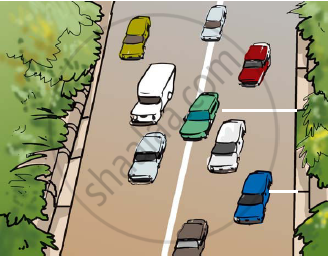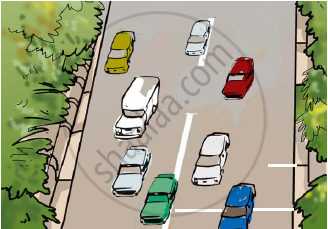Advertisements
Advertisements
प्रश्न
Suppose the two photographs, shown in Figure 1 and Figure 2, had been taken at an interval of 10 seconds. If a distance of 100 metres is shown by 1 cm in these photographs, calculate the speed of the fastest car.

Figure 1 Vehicles moving in the same direction on a road

Figure 2 Position of vehicles shown in Figure 1 after some time
उत्तर
The distance covered by the blue car (as evident from the photograph) from one white strip to another, measured by scale, is 1.4 cm.
It is given that 1 cm is equivalent to 100 m.
Therefore, 1.4 cm is equivalent to 140 m.
Distance travelled by the car = 140 m
The time interval between the two photographs = 10s
Speed = `"Distance covered"/"Time taken"`
= `140/10`
= 14 m/s
APPEARS IN
संबंधित प्रश्न
What do you understand by the average speed of a body?
A boy covers half of his journey with a uniform speed of u and the other half with a uniform speed of v. What is the average speed for the whole journey?
The relation S= v x t can easily be used to find the tota l distance covered by a body moving with non -uni form speed. (Yes/ no)
The correct relation among the following is
A vehicle covers a distance of 400km in 5 hours. Calculate its speed.
The speed of a train is expressed in m/h.
What is the unit of average speed in SI system?
A car increases its speed from 20 km/h to 50km/h in 10 seconds. Its acceleration is ______.
If Boojho covers a certain distance in one hour and Paheli covers the same distance in two hours, who travels at a higher speed?
Assertion: The speed of a body can be Negative.
Reason: If the body is moving in the opposite direction of positive motion, then its speed is Negative.
